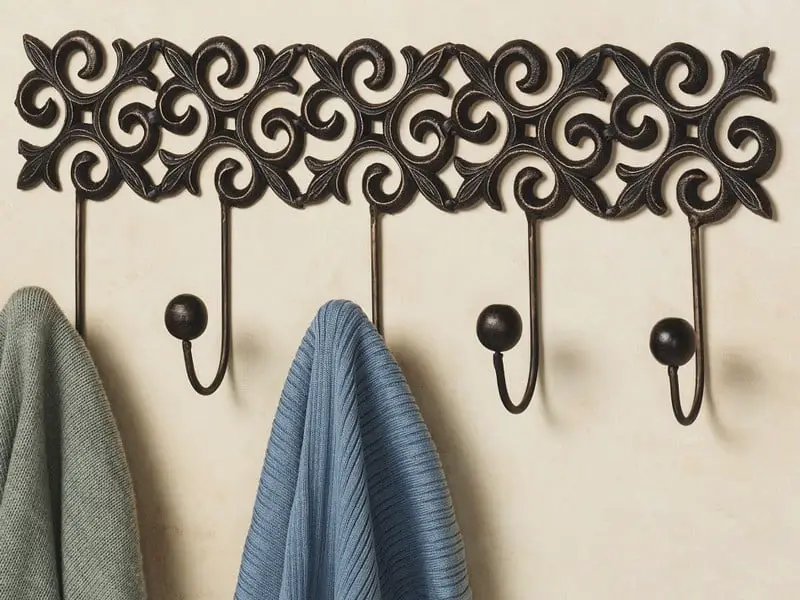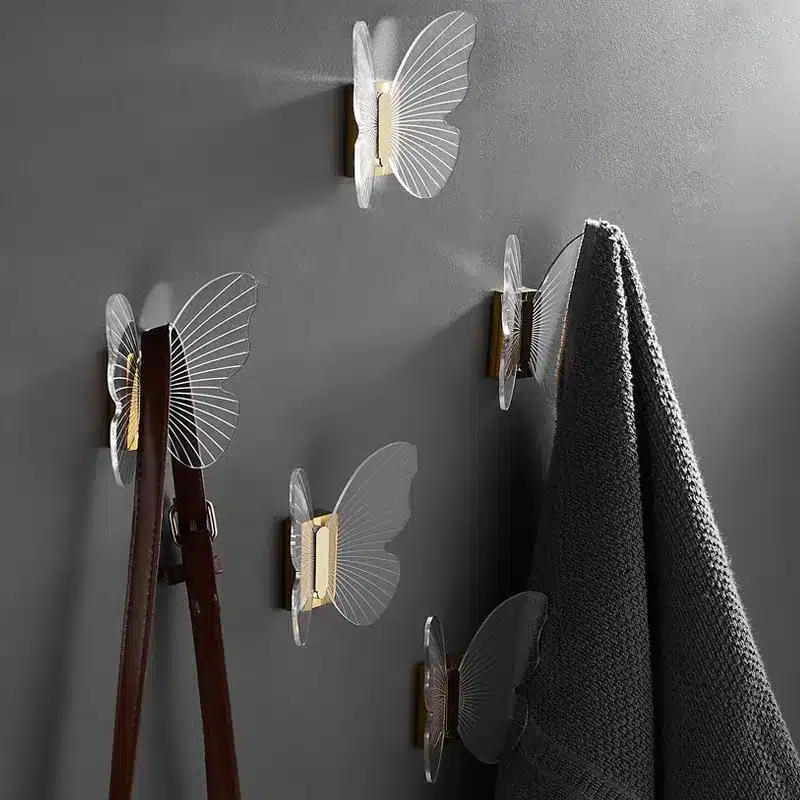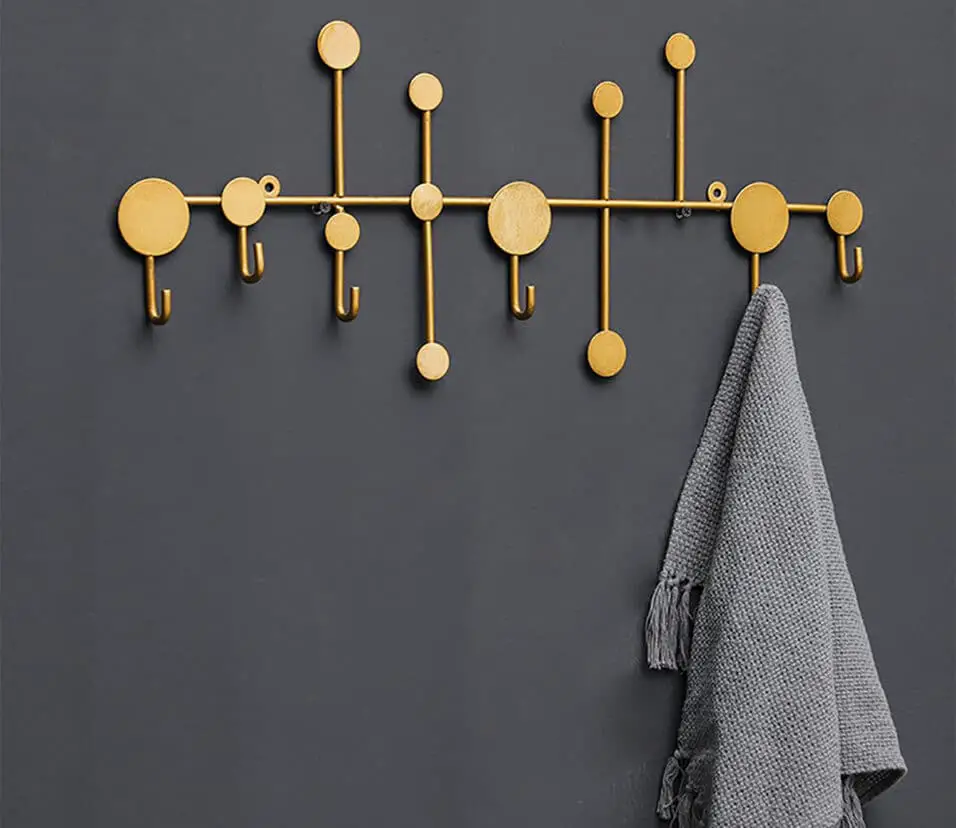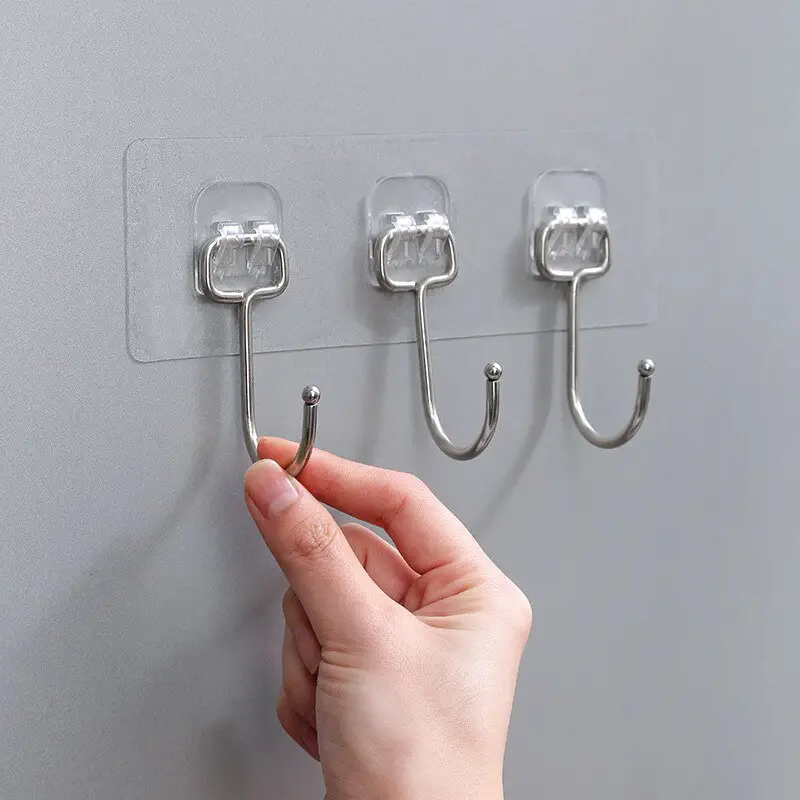How To Install Wall Hooks Without Drill
Introduction
How To Install Wall Hooks Without Drill: Wall hooks are a versatile and practical solution for organizing and decluttering your living space. Whether you want to hang coats, hats, towels, or other items, wall hooks provide a convenient and efficient way to keep things tidy. However, the thought of drilling holes into your walls might be daunting, especially if you are renting or prefer not to damage your walls. The good news is that there are alternative methods available for installing wall hooks without the need for a drill. In this article, we will explore different techniques and provide step-by-step instructions on how to install wall hooks without drilling.
Using Adhesive Hooks: One of the easiest and most popular methods for installing wall command hooks without a drill is by using adhesive hooks. These hooks come with a strong adhesive backing that allows them to stick securely to various surfaces, including painted walls, tiles, and glass. To install adhesive hooks, start by cleaning the surface where you want to place the hook with rubbing alcohol to ensure proper adhesion. Then, remove the protective backing from the adhesive and firmly press the hook against the wall for a few seconds. It is important to follow the manufacturer’s instructions regarding weight limits and surface compatibility to ensure the hooks can support the items you intend to hang.
Using Tension Rods: If you prefer a temporary solution or want to avoid adhesive hooks altogether, tension rods can be a great alternative. Tension rods are adjustable rods that rely on pressure to stay in place. To install wall hooks using tension rods, start by measuring the width of the space where you want to hang the hooks. Then, choose a tension rod that fits snugly within that width. Insert the tension rod into the desired location, and twist it until it is securely in place. Once the tension rod is installed, you can hang S-hooks or other types of hooks from it to hold your items.
Using Over-the-Door Hooks: Another convenient option for installing wall hooks without drilling is by using over-the-door hooks. These hooks are designed to hang over the top of a door, providing a quick and easy solution for adding extra storage space. To install over-the-door hooks, simply place the hooks over the top of the door and adjust them to your desired height. Make sure the hooks are securely in place before hanging any items on them. Over-the-door hooks are particularly useful in areas such as bathrooms, bedrooms, or closets where you may need additional hanging space.
By utilizing these alternative methods, you can easily install wall hooks without the need for a drill. Whether you choose adhesive hooks, tension rods, or over-the-door hooks, these techniques offer a practical and non-permanent solution for organizing your space. Now, let’s dive into the step-by-step instructions for each method to help you get started on your wall hook installation journey.

How do you hang something on the wall without drilling?
Adhesive hooks
Apply a stick-on strip to the wall and to the back of the hook. Line them up and stick them together. Then all that’s left to do is hang your chosen décor onto the hook.
Introduction:
Hanging something on the wall without drilling can be a convenient and practical solution, especially for those who live in rented spaces or prefer not to damage their walls. Fortunately, there are several alternative methods available that allow you to hang items securely without the need for drilling. These methods range from adhesive hooks and strips to tension rods and picture hanging systems. By exploring these options, you can find the perfect solution for your specific needs and preferences.
Adhesive Hooks and Strips:
One popular method for hanging items without drilling is by using adhesive hooks and strips. These hooks are equipped with strong adhesive backing that can securely hold lightweight to medium-weight items. To use adhesive hooks, simply clean the wall surface, peel off the backing, and press the hook firmly against the wall. Adhesive strips work similarly, but they allow you to attach items such as picture frames or mirrors directly to the wall. It is important to follow the manufacturer’s instructions and weight limits when using adhesive hooks and strips to ensure proper adhesion and prevent damage to the wall.
Tension Rods:
Tension rods are another versatile option for hanging items without drilling. These rods work by using tension to hold themselves securely between two walls or other surfaces. They are commonly used for hanging curtains, but they can also be used to hang lightweight shelves, artwork, or other decorative items. To use a tension rod, simply adjust its length to fit snugly between the walls, and then twist it to create tension. This will hold the rod in place and provide a stable support for your hanging items.
Picture Hanging Systems:
If you are looking for a more professional and flexible solution, picture hanging systems can be a great choice. These systems consist of a track that is mounted on the wall, along with adjustable hooks or wires that can be attached to your items. The track allows you to easily move and rearrange your artwork or decorations without the need for drilling new holes. Picture hanging systems are particularly useful for those who frequently change their wall displays or have a large collection of artwork.
There are several effective methods available for hanging items on the wall without drilling. Adhesive hooks and strips provide a simple and temporary solution, while tension rods offer versatility and stability. For a more professional and flexible option, picture hanging systems are an excellent choice. By considering your specific needs and preferences, you can find the perfect method to hang your items securely and without damaging your walls.
Can we stick adhesive hook on wall?
This is a must have wall adhesive hooks for hanging. These stick on hooks look very neat and easily maintained. How to install: 1. Before installing the adhesive hook, please make sure the surface is clean, dry, free from dust and oil, and wipe it dry first.
Introduction:
When it comes to decorating our living spaces, finding ways to hang items on the wall without causing damage can be a challenge. Adhesive hooks have become a popular solution for many, offering a convenient and damage-free way to hang various items. In this article, we will explore the effectiveness of adhesive hooks and discuss whether they can be safely used on walls.
Benefits of adhesive hooks:
Adhesive hooks are designed to securely stick to surfaces without the need for nails or screws. They offer several advantages that make them an attractive option for wall hanging. Firstly, they are easy to install and remove, making them ideal for temporary displays or renters who cannot make permanent changes to their walls. Additionally, adhesive hooks are versatile and can support a range of items, including lightweight frames, mirrors, and decorations.
Factors to consider:
While adhesive hooks can be a convenient solution, it is important to consider a few factors before using them on your walls. Firstly, the type of wall surface plays a crucial role in determining the effectiveness of adhesive hooks. Smooth surfaces such as painted walls or glass tend to provide better adhesion compared to textured or porous surfaces like brick or concrete. It is essential to ensure that the surface is clean and dry before applying the adhesive hook to maximize its sticking power.
Weight capacity:
Another important consideration is the weight capacity of the adhesive hook. Each hook is designed to support a specific weight limit, which should be clearly indicated on the packaging. It is crucial to adhere to these weight limits to prevent any damage to the wall or the item being hung. If you are unsure about the weight of the item, it is always better to choose a hook with a higher weight capacity to be on the safe side.
Conclusion:
Adhesive hooks can be a practical and damage-free solution for hanging items on walls. They offer ease of installation and removal, making them suitable for temporary displays or rental properties. However, it is important to consider the type of wall surface and adhere to the weight capacity limits specified by the manufacturer. By following these guidelines, you can safely and effectively use adhesive hooks to hang various items on your walls without causing any damage.
Can I use a screwdriver instead of a drill?
A power screwdriver can be used as a drill.
Keep in mind that a power screwdriver has a lower RPM than a traditional drill. Therefore, it is recommended to use it to drill in soft materials (e.g. Wood and mortar).
Can I use a screwdriver instead of a drill?
Many people wonder if they can use a screwdriver instead of a drill for various tasks. While a screwdriver and a drill may seem similar, they serve different purposes and have distinct features. In this article, we will explore whether it is possible to substitute a screwdriver for a drill and discuss the limitations and considerations involved.
Firstly, it is important to understand the primary functions of a screwdriver and a drill. A screwdriver is a handheld tool specifically designed for driving screws into various materials. It typically has a handle and a shaft with a flat or Phillips head for turning screws. On the other hand, a drill is a power tool that rotates a drill bit to create holes in different surfaces, such as wood, metal, or plastic. It can also be used for driving screws by attaching a screwdriver bit.
While a screwdriver can be used for light-duty tasks, such as assembling furniture or tightening small screws, it is not suitable for more demanding projects that require drilling holes. The main reason is that a screwdriver lacks the power and speed of a drill. When drilling holes, a drill applies rotational force and downward pressure simultaneously, allowing the bit to penetrate the material efficiently. A screwdriver, on the other hand, relies solely on manual force, making it less effective and time-consuming for drilling tasks.
Moreover, using a screwdriver instead of a drill can potentially damage both the tool and the material being worked on. The lack of power and control can cause the screwdriver to slip or strip the screw head, leading to frustration and potential damage to the workpiece. Additionally, using a screwdriver for drilling tasks can strain your hand and wrist due to the increased effort required compared to using a drill.
While a screwdriver can be used as a temporary substitute for light-duty tasks, it is not recommended to use it instead of a drill for drilling holes or heavy-duty projects. Investing in a good quality drill will provide you with the necessary power, speed, and versatility to tackle a wide range of tasks efficiently and effectively.
Can you mount something without a drill?
If you don’t want to drill a hole for a drywall anchor but are okay with using a nail, you can use a no-stud wall mount secured with small nails. The no-stud wall mount will still damage the wall, but the holes are much smaller and easier to fill than large drilled holes.
Introduction:
Mounting something without a drill can be a challenging task, especially when you don’t have access to power tools or want to avoid damaging the surface you are working on. However, there are alternative methods and techniques that can help you achieve your goal without the need for a drill. Whether you are looking to hang a picture frame, install a shelf, or mount a TV, these methods can come in handy.
Using Adhesive Hooks:
One of the easiest ways to mount something without a drill is by using adhesive hooks. These hooks come with a sticky backing that allows you to attach them to various surfaces, such as walls or doors, without causing any damage. They are ideal for hanging lightweight items like picture frames, small mirrors, or decorative pieces. Simply clean the surface, peel off the backing, and press the hook firmly against the wall. Make sure to follow the weight limit specified by the manufacturer to ensure a secure hold.
Utilizing Tension Rods:
Tension rods are another versatile option for mounting items without a drill. These adjustable rods can be used to create temporary shelving or hang curtains, among other things. To use a tension rod, measure the width of the space you want to mount it in and choose a rod that fits snugly. Twist the rod to extend it until it fits tightly between the walls or other surfaces. This method is particularly useful for renters or those who frequently change their decor since tension rods can be easily removed without leaving any marks.
Exploring Command Strips:
Command strips are a popular choice for mounting items without a drill. These adhesive strips are designed to hold various objects securely to the wall and can be easily removed without causing any damage. They come in different sizes and weight capacities, allowing you to choose the appropriate strip for your needs. To use command strips, clean the surface, attach the strip to the item you want to mount, and press it firmly against the wall. Follow the instructions provided by the manufacturer to ensure proper adhesion and weight distribution.
Mounting something without a drill is indeed possible with the help of alternative methods such as adhesive hooks, tension rods, and command strips. These options provide a convenient and damage-free way to hang various items, making them suitable for renters, those who prefer temporary solutions, or anyone who wants to avoid drilling into their walls. By utilizing these techniques, you can achieve a secure and aesthetically pleasing mount without the need for power tools.
How do you make a hole without a drill?
Introduction:
Creating a hole without a drill can be a challenging task, but it is certainly possible with the right techniques and tools. Whether you don’t have access to a drill or simply prefer alternative methods, there are several creative ways to achieve your goal. In this article, we will explore some effective methods that can help you make a hole without a drill.
Method 1: Using a Hammer and Nail:
One of the simplest ways to create a hole without a drill is by using a hammer and nail. Start by marking the spot where you want the hole to be and place the nail on the mark. Hold the nail firmly in place and gently tap the head with the hammer. Gradually increase the force until the nail pierces through the material. This method works best for softer materials like wood or thin metal.
Method 2: Utilizing a Screwdriver:
If you don’t have a drill but have a screwdriver, you can still make a hole. Choose a screwdriver with a sharp and pointed tip. Position the screwdriver on the marked spot and apply pressure while rotating it clockwise. Continue this motion until the screwdriver penetrates the material and creates a hole. This method is suitable for softer materials and can be particularly useful for small holes.
Method 3: Using a Hole Saw:
When dealing with larger holes, a hole saw can be a handy tool. A hole saw consists of a cylindrical saw blade with teeth that can cut through various materials. Attach the hole saw to a power drill or a hand drill and position it on the marked spot. Apply steady pressure and start drilling slowly. The teeth of the hole saw will gradually cut through the material, creating a clean and precise hole. This method is ideal for materials like wood, plastic, or thin metal sheets.
Method 4: Employing a Rotary Tool:
A rotary tool, such as a Dremel, can be a versatile alternative to a drill. It comes with various attachments, including cutting bits and grinding stones, which can be used to create holes. Select an appropriate attachment for your material and attach it to the rotary tool. Hold the tool firmly and slowly guide it to the marked spot, applying gentle pressure. The rotary tool will gradually carve out the hole, allowing you to achieve the desired result. This method is suitable for a wide range of materials, including wood, metal, and plastic.
By utilizing these methods, you can successfully make a hole without a drill. Remember to exercise caution and wear appropriate safety gear when using any tools. Whether you opt for a hammer and nail, a screwdriver, a hole saw, or a rotary tool, each method offers its own advantages and can be effective depending on the material and hole size you require.
When it comes to installing wall hooks without using a drill, there are several alternative methods you can consider. One option is to use adhesive hooks, which can be a convenient and easy solution. These hooks typically come with a strong adhesive backing that allows them to stick securely to the wall surface. Simply peel off the protective backing and press the hook firmly against the wall.
Another alternative method is to use removable adhesive strips or hooks. These strips are designed to be easily removable without causing damage to the wall. They often come with a hook or loop attachment that can be used to hang items. To install, you would simply peel off the backing, press the strip against the wall, and then attach the hook or loop.
If adhesive options are not suitable for your needs, there are also tension-based hooks available. These hooks rely on tension and pressure to stay in place, without the need for drilling or adhesive. They typically feature a spring-loaded mechanism that allows them to grip onto the wall securely. To install, you would simply position the hook where you want it, and then adjust the tension until it feels secure.
Can adhesive hooks be used as a substitute for drilling holes when installing wall hooks?
Yes, adhesive hooks can indeed be used as an alternative to drilling holes when installing wall hooks. These hooks are designed with a strong adhesive backing that allows them to stick securely to various surfaces, such as painted walls, tiles, glass, and even metal. They provide a convenient and hassle-free solution for hanging lightweight items, such as keys, small decorations, or towels.
However, it is important to note that adhesive hooks have their limitations. They may not be suitable for hanging heavy or bulky items, as the adhesive strength may not be sufficient to support the weight. It is always recommended to check the weight capacity specified by the manufacturer before using adhesive hooks for heavier objects. Additionally, the surface on which the adhesive hook is applied should be clean, dry, and free from any dust or grease to ensure proper adhesion.
Are there any specific types of wall hooks that are designed for easy installation without the need for a drill?
Yes, there are several types of wall hooks that are specifically designed for easy installation without the need for a drill. One popular option is adhesive hooks. These hooks come with a strong adhesive backing that allows them to stick securely to the wall without the use of any tools. They are easy to install and can be removed without leaving any damage or residue behind.
Another type of wall hook that does not require drilling is the suction cup hook. These hooks use suction to adhere to smooth surfaces such as glass or tile. They are ideal for bathrooms or kitchens where drilling may not be an option. However, it’s important to note that suction cup hooks may not be as strong as adhesive hooks and may not be suitable for holding heavy items.
Overall, adhesive hooks and suction cup hooks are great alternatives to drilling when it comes to installing wall hooks. They offer convenience and ease of installation, making them perfect for renters or those who prefer not to use power tools. Just ensure to follow the manufacturer’s instructions and weight limits to ensure the hooks are used correctly and securely.
Are there any potential drawbacks or limitations to using non-drill methods for installing wall hooks?
While non-drill methods for installing wall hooks can be convenient and time-saving, they do come with some potential drawbacks and limitations. One of the main limitations is the weight capacity of the hooks. Non-drill methods, such as adhesive hooks or suction cups, may not be able to support heavy items as securely as hooks installed with a drill. It’s important to carefully consider the weight of the items you plan to hang and choose a non-drill method that can adequately support them.
Another drawback is the potential for damage to the wall surface. Adhesive hooks, for example, can leave residue or even peel off paint when removed. Suction cups may not adhere well to certain wall textures or surfaces, leading to a less secure hold. It’s essential to follow the manufacturer’s instructions and properly prepare the wall surface before using non-drill methods to minimize the risk of damage.
Additionally, non-drill methods may not be suitable for all types of walls. Some walls, such as those made of concrete or brick, may require drilling for a secure installation. It’s important to assess the composition of your walls and choose a suitable method accordingly. If unsure, consulting a professional or seeking advice from a hardware store can help ensure you choose the right method for your specific wall type.
Are there any tips or tricks for ensuring that wall hooks installed without a drill are secure and able to hold heavy items?
When it comes to installing wall hooks without a drill, there are a few tips and tricks that can help ensure they are secure and capable of holding heavy items. Firstly, it is important to choose the right type of adhesive hook that is specifically designed for heavy-duty use. Look for hooks that have a high weight capacity and are made from durable materials.
Before applying the adhesive hook, make sure the surface of the wall is clean and dry. Remove any dust, dirt, or grease that may prevent the adhesive from sticking properly. It is also recommended to use rubbing alcohol to clean the area where the hook will be placed, as this can help improve the adhesion.
When applying the adhesive hook, press firmly and hold it in place for a few seconds to ensure a strong bond. Avoid hanging heavy items immediately after installation and allow the adhesive to cure for the recommended time mentioned on the product packaging. Additionally, it is advisable to avoid placing excessive weight on the hook initially to prevent any potential damage.

Conclusion
Installing wall hooks without a drill can be a convenient and practical solution for those who want to avoid the hassle of drilling holes in their walls. Whether you are renting a space or simply prefer not to damage your walls, there are several methods available that can help you achieve a secure and sturdy installation. By following these instructions, you can easily hang wall hooks without the need for a drill.
One method to install wall hooks without a drill is by using adhesive hooks. These hooks come with a strong adhesive backing that allows them to stick to the wall securely. Simply clean the surface of the wall, peel off the backing of the adhesive hook, and press it firmly against the wall. Make sure to follow the manufacturer’s instructions for weight limits and surface compatibility. Adhesive hooks are a great option for lightweight items such as keys, small decorations, or lightweight clothing.
If you need to hang heavier items, another option is to use adhesive strips or hooks that are specifically designed for heavier loads. These strips often come with a stronger adhesive and can support more weight. It is important to carefully read and follow the instructions provided by the manufacturer to ensure a proper installation. Additionally, make sure to choose a suitable surface for the adhesive strips, as some may not adhere well to certain types of walls or surfaces.
Another alternative to drilling is using tension rods or over-the-door hooks. These types of wall hooks do not require any permanent installation and can be easily adjusted or removed as needed. Tension rods can be placed between two walls or surfaces, providing a secure and temporary solution for hanging items such as towels or clothing. Over-the-door hooks can be hung over the top of a door, allowing you to utilize the unused space behind the door for hanging coats, bags, or other items.
Installing wall hooks without a drill is a feasible option for those who want to avoid drilling holes in their walls. Adhesive hooks, adhesive strips, tension rods, and over-the-door hooks are all effective alternatives that can provide a secure and convenient solution for hanging various items. It is important to carefully follow the instructions provided by the manufacturer to ensure a proper installation and to choose the appropriate method based on the weight and type of items you wish to hang. By utilizing these methods, you can enjoy the benefits of wall hooks without the need for a drill.








